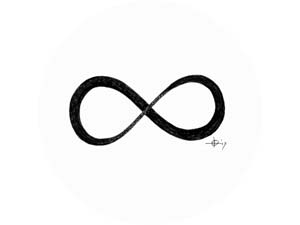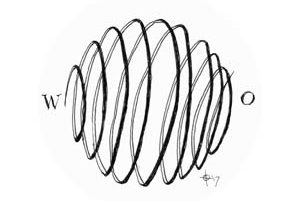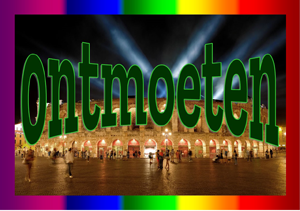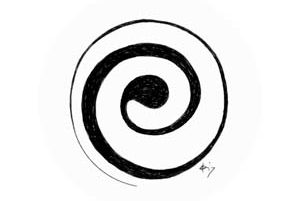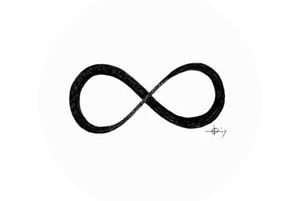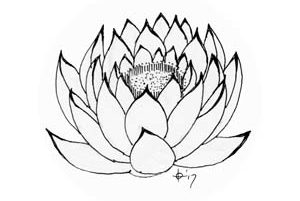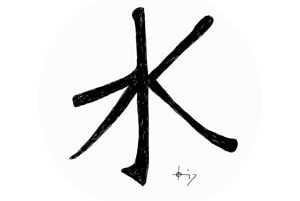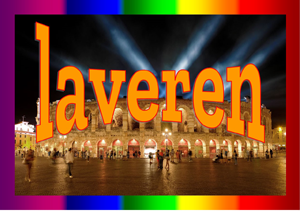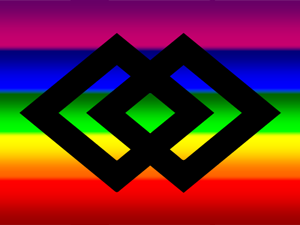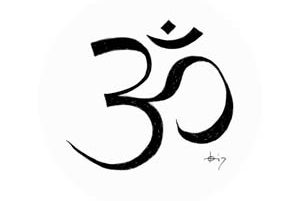Erik Hoogcarspel
Part 1 ― part 2
In an article that appeared on August 4 in the Dutch newspaper De Groene Amsterdammer a courageous and in my opinion successful attempt was made to explain the essence of quantum physics. In this article Quantum physics is called the biggest revolution of our times. The journalist, Sanne Bloemink, even talks about an almost mystical experience.
“Sudden shocks of deep understanding which make waves through one’s whole-body. The feeling that everything is totally different from what is expected at the same time fully makes sense”[1]
Some readers may recognize this feeling. It often happens during a conversation at a birthday party or in the pub that someone starts to talk enthusiastically about quantum physics. The others listen with full attention almost holding their breath but the conversation usually ends in deep silence. Drinks anyone?
Founding quantum mechanics
The mysticism of emptiness
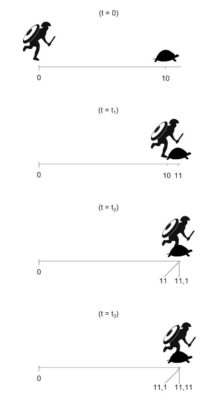
A similar experience might occur occasionally, for instance, when someone reads that all kinds of things from daily life ― like causality or movements for instance ― actually don’t exist. Some are taken by it in such a way that they read everything they can find about it, start inventing complicated series and come up with all kinds of smart word puns.
These people will experience some kind of confirmation when reading in the same article that one of the foremost quantum physicists is an admirer of the work of Nāgārjuna and even associates Nāgārjuna’s Madhyamika philosophy to quantum physics. In his book “Helgoland” quantum physicist Carlo Rovelli even suggests this kind of philosophy may contain solutions to the riddles that still remain in quantum physics.
In the interview Rovelli says:
“This was just what I was looking for in philosophy. How can we think in terms of relationships? Relationships of what? You do need things before you can talk about relations between things? Nāgārjuna shows in a very subtle way that it is just your other way around. One just starts from the facts that there is no meaning in relationships, and one by one he takes all things away that could be things. Great! And then comes this chapter that really blew me away, about the emptiness of emptiness. He says in fact: your mind is looking for a basis. But why is this search really the right one? Why do we need a basis? To think about the world in this way is a child’s dream. Even this argument I give you now about emptiness: don’t take this as a basis for reality.”
Nothingness as a dogma
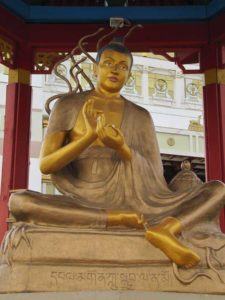
Everyone who reads Nāgārjuna closely however, would see that there are some reasons for doubts. In chapter 8, verse 13, Nāgārjuna says that the teaching of emptiness is the transcendence of all views, but he warns not to make the mistake to turn the teachings of emptiness itself into a view.
On top of that it seems to be very optimistic of Rovelli to presume that quantum mechanics, and science in general for that matter, can do without a basis. Science came into being in the 16th century out of the attempt to discover by which ideas God had been creating the world. This search was assumed to be God’s purpose and it would bring humanity prosperity and happiness. Since then God has disappeared from science off course, but His ideas have lingered on in the shape of natural laws, that have become more and more mathematical laws.
The assumption that science does not need any basis whatsoever, implies that there is nothing left to explain, and that no explanation makes any sense because one is not explaining anything to anyone, nor referring to anything else. Nāgārjuna rightly observes in chapter 4, verse 8, that if someone in an argument makes an objection by referring to emptiness, he refutes his own claim together with the claim of his opponents.
Three zeros

It has often been suggested that emptiness has entered mathematics in the shape of the number zero. It is also well known that a description of the number zero and how to deal with it has been described for the first time in the year 628 in an Indian astronomical text.
The symbol of zero comes however in three flavors. Sometimes it merely means “nothing”. This concept has never been discovered, because human beings are born with it, even animals understand that there is no more food left if they don’t find anything. The milk has gone means that there is no more milk, that the quantity of milk available has become zero.
The second meaning is part of arithmetic and it arises as soon as one starts to calculate large numbers by writing, using the sequence and place of ciphers as an indication of their value. The number 1 indicates one unity, but if it is followed by three zeros, it suddenly means 1000 units. This is because the place of the cipher 1 has a meaning and this is in this case indicated by three following empty places. We indicate these empty places by the cipher zero. The use of a separate symbol for this kind of empty places dates already from before the year 1500 BCE and it was known in Egypt and Babylonia.
The zero as a number of which the handling was described in India for the first time, only arises when we start to calculate. As long as we don’t do anything else but adding, nothing happens. As soon as we also start to subtract, it occurs that the outcome of the subtraction may be zero. From that moment on the zero counts as a number like other numbers and therefore it becomes possible to use it in division and multiplication.
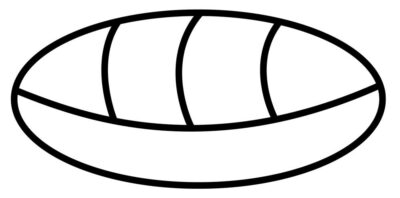
So we have 3+0=3, 3-0=3, 3×0=0, 3:0=? infinity? The division shows that mathematics has very loose ties to the real world. It is for instance not uncommon that one still has 3 pizzas if one initially used to have 3 and nothing has been added. Even if one still has 3 pizzas after having initially 3 and nothing has been taken away, nobody will be surprised. It is also considered to be not surprising that one has no pizzas if one forgets to buy 3 pizzas (3×0). Moreover if two people have to share 3 pizzas, each usually gets one and a half (3:2=1½). It is however very puzzling if a group of zero people has to share 3 pizzas, nobody ends up with an infinity of pizzas (3:0).
The conclusion can only be that mathematics is different from daily life. It is a conventional system that man invented in order to make his world more livable. We establish a temporary and fragile relationship between mathematics and reality by counting and measuring.
One cannot be bothered by what doesn’t exist
It has become clear by now that the kind of emptiness that Nāgārjuna discusses has nothing to do with mathematics. Emptiness itself is according to Nāgārjuna merely a conventional concept that expresses the view that all things need to depend on each other in order to have any meaning (chapter 24, verse 18). The expression is used because it has a lot in common with the oldest meaning of zero, which is missing something one expects to find. It expresses the view of the Middle Way, meaning that one can neither establish that things exist nor that they don’t exist (chapter 9, verse 12).
Nāgārjuna clearly expresses his intentions to explain the teachings of the Buddha and he doesn’t seem to have the intention to give a new explanation of quantum physics. Therefore there is ample reason to wonder whether Rovelli has fully understood what Nāgārjuna is trying to make clear. The Buddha did not want to invent a basis for science, he wanted to show the way to nirvāṇa, the state of peace of mind beyond all suffering.
It is however not easy to tell what is wrong with the explanation of Rovelli, everything seems to fit. Apparently the problem is the perspective from which Rovelli has been reading Nāgārjuna. Nāgārjuna’s perspective seems to be very abstract, but on the contrary it is too obvious. It is about the idea we have of reality as a whole and our very relationship with it. It is about what the philosopher Max Scheler called: “Die Stellung des Menschen im Kosmos” (The position of man in the Cosmos). In the next three chapters I will review three of these perspectives and try to show how to understand Nāgārjuna and what Rovelli and his allies have overlooked.
The gaze from above
The riddles of quantum physics
According to physicist and philosopher Bernardo Kastrup, the bizarre findings on the level of quantum mechanics force us to look in a totally different way at the nature of our measurable reality as well as at the future of science and even at our very own consciousness (Dutch podcast NRC newspaper “Future Affairs”, March 4 of 2021 “how quantum physics turns our view of the world upside down”). According to Kastrup quantum physics turns our view of the world upside down, but what is this view of the world really and how has it become as it is?

Scientists like to think that the world we experience is the real one, according to Kastrup, but they are mistaken. The world in itself is created by another reality which is not a measurable or perceptible one. It is however not useless to practice science, because nature behaves in most cases as if it really is how it looks. Therefore science can solve our practical problems, but it fails to solve all of our theoretical problems. Kastrup considers our eyes and ears to be merely instruments. They only pass on data of the real world without giving us any possibility to actually perceive where they come from. We are like a pilot in a cockpit of an airplane of which the windows are blinded by a heavy storm and who has to rely on his instruments to reach the airport. So Kastrup thinks there is a reality behind the reality we perceive. Our consciousness belongs to this deeper reality, it is not a byproduct of our brains. The laws of nature are the shapes by which a universal anonymous original consciousness manifests itself.
The presenters of the podcast, Wouter van Noort and Jessica van der Schalk, are very impressed, but this idea is absolutely not new. The thought that the material reality is nothing but an imperfect image of and immaterial true and perfect reality, was already advocated by Plato (427-347 BCE). Van der Schalk, who has been studying philosophy, overlooks this fact. The philosophical term for this view is “metaphysical realism”, it is the theory that says that the true reality is beyond nature, in other words metaphysical. Plato still thought that we could catch a glimpse of this higher reality through our capacity for intuition, through our inner sense. This has created jobs for many a philosopher and even more for quite a few theologians after him, providing some of them with a lot of authority, status and money.
Yogācāra
We can find this kind of metaphysical realism also in Buddhism, it is called the Yogācāra philosophy. It teaches that all appearances arise because of a certain structure of consciousness and that this structure has to be reverted in order to reach true insight. Vasubandhu writes in verse 29 of his Trimśikā:
“The cognition without objects has knowledge of the transcendental world, it is the end of the two sources of suffering because the fundamental cognition has been turned upside down”.
In the Viṁśatikā Vasubandhu leaves no room for doubt. He states that the things we perceive are illusions, they don’t exist in reality. They only exist for our cognition, like in a dream. It is however possible to obtain transcendental knowledge, which is the knowledge of a Buddha. According to the later theory of the tathātagagarbha every human being possesses the seeds of this knowledge.

Another example of metaphysical realism is Advaita Vedānta. It teaches that the real world is Braḥman, while the world we live in is merely an illusion (maya), which arises through our ignorance because we cover up (adhyāsa) reality with our limited conventional concepts.
A recent example of metaphysical realism is the comparative philosophy of Ulrich Libbrecht (1928–2017). He created a comparative model that assembles all religions of the world in an encompassing structure. The purpose was to
“… confront human beings with deeds defects and blind spots of their own culture.”
“… de mens confronteert met de defecten en blinde vlekken van de eigen beschaving.”
Michel Dijkstra (2012): Oosterse filosofie, p. 113.
The model describes the human mental universe which has patterns of mental formations of energy and information. Libbrecht is convinced that he understands the “cosmic logic” (Burger van de wereld (2013), p.13), which implies that he himself has transcended the world and surveys it in its totality with his philosophical gaze.
Metaphysical realism claims in other words that a metaphysical knowledge is possible which judges the world in its totality from outside. This knowledge arises when one turns away from the world and becomes aware of the center of the world which is located outside the world, but inside the mind of the philosopher. This means that the center of the world is not outside us, but to be found anywhere within. If one wants to reach it and obtain higher knowledge, one has to turn away from the world and turn inwards into one’s own mind. Apart from this nothing in the world has a center of its own, all worldly appearance is just empty and idle.
Kochumuttom, who translated the works of Vasubandhu, recognizes the similarity between the ultimate reality that Vasubandhu mentions and the Kantian Thing in Itself (p. XXI). This ultimate reality is also not very different from the Platonian realm of metaphysical ideas, which became the realm of angels or divine ideas in Christian theology. In all cases we find three layers of reality: the material and worldly one, the layer of mutual dependence and logic, and the one of absolute being. In all cases the middle one is the most important, because it enables the communication between the other two. Without it, both other layers would be each absolutely useless and absurd. Besides, it justifies the text and the philosopher themselves, because without the middle layer neither one would be possible.
Reality itself

In the year 1781 the higher theological knowledge was called into question by Immanuel Kant’s book “Critique of pure Reason”. Kant had been reading David Hume and had been convinced that a number of concepts, like for instance causality and the self, are devoid of an empirical basis. This left him with two possibilities: either we just invent these concepts, or we are born with them. The latter possibility had been discarded by a number of philosophers before him. If however we would just imagine these concepts, it would exclude them from reality. The consequence of this would be that all science would be a product of our imagination and would therefore not provide us with any adequate knowledge of the world. Kant considered this to be unthinkable.
In his “Critique” he presents his solution: we don’t perceive the world like it is, the world is like we perceive. This implies there are two realities: the real one and the one which appears to us. Our senses and our understanding, which is coordinating the senses, are nothing but instruments by means of which we collect data of the real world (das Ding an Sich). These data are used by the same understanding (Verstand) together with our imagination to provide us with a representation of the world.
This is exactly the model described by Kastrup. We will never know the real world like it is in itself. For some time Kant did not exclude the possibility that in special cases we could catch a glimpse of this true reality. This was the reason why he studied the work of the ― at the time famous ― clairvoyant Emanuel Swedenborg (1688–1772). In the end his conclusion was that the most important book of the latter,
“Arcana Celestia”, was nothing but “… eight volumes full of nonsense…” were nothing was to find but “… speculative musings of a confused mind…” (Träume eines Geistersehes und andere vorkritische Schriften, page 364:
“… acht Quartbänder voll Unsinn…” and “… speculative Hirngespinste einer verkehrt grübelenden Vernunft…”).
Kant decided therefore that we cannot possibly know anything that doesn’t play by the rules of laws of nature and that these natural laws are nothing but the constructions of our own mind. These constructions however are necessary, and they are not consciously made on the basis of personal choice and taste. Nature and her laws are a part of the reality in itself, so we don’t know them directly. It is however possible to deduce the nature of their activity by analyzing the appearances we are confronted with. We observe for instance that appearances are causally related, so causality is one of these constructions. We also observe that all our perceptions are united into one unity, which suggests a knowing self, a unifying structure of our consciousness. So although there seems to be an absolute abyss between the world in itself and the appearing world, this abyss is bridged by our analysis, in other words by logic. Logic enables us to find the necessary conditions that make all appearances possible. Perhaps Kant would have written a different book if he had been acquainted with quantum physics.
Individualism
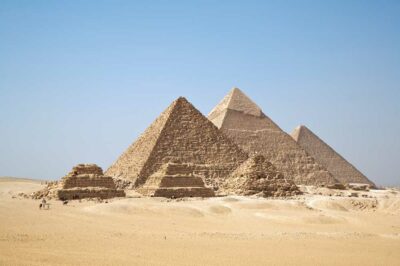
The philosophy of Kant marks the passage from a collective and hierarchical view of the world to an individualistic and flat one. It is the time of the French Revolution (1798–1799) and Kant admired the works of Jean-Jacques Rousseau (1712–1778), who arguably invented democracy. Most people at the time were still thinking in terms of hierarchy, the world was the “Great Chain of Being”, a continuum in which everything and every being had its own fixed place. We still have the symbolic remains of this model of the world in the form of royalty and nobility, and in all kinds of expressions and sayings where it is suggested that these people are better and happier than normal human beings.
The great chain of being is a smooth pyramid without interruptions. It starts at the most elementary level and finds its culmination in the supreme God. A similar model of the world used to exist and still exists in India and China. We are reminded by this by the caste system in India and the extreme importance of reputation and status in China. It is also present in Buddhism in the form of the representations of different worlds, hells and heavens, where all kinds of different beings and gods are living and in the representations of all the different mandalas (environments) of Buddhas and bodhisattvas. In most stories about his personal life the Buddha himself is obviously depicted as a prince and besides, Buddhism is replete with stories about kings and princes.
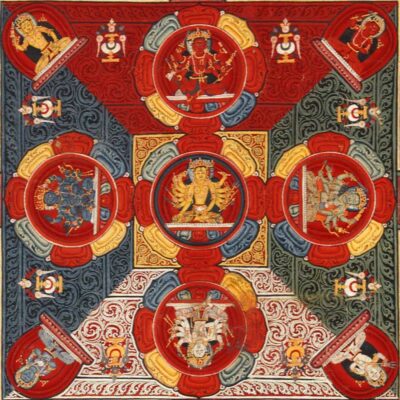
In the great chain of being every thing and every being has its on purpose and its own place. Man finds himself at home in it and also finds there his own destiny, be it in the hereafter or in a next life. In this model of the world inequality and difference in status are natural and even necessary. The reason why they exist is a secret, because this is outside knowledge only known by God. For man everything happens to be like it is and can not possibly otherwise. Everything is given, everything is perceivable, everything is surface. The center, the secret of reality is nowhere to be found in the world and is only known by an elite of mystics who have crossed the barriers of the worldly mind. Those extraordinary beings have found the secret of the world by withdrawing their interests from the world and turning into themselves. There they find the center of the world, the origin of all meaning. This model has been described by the philosopher Marc Richir as an infinite sphere of which the circumference is everywhere and the center nowhere.
The problem of this model is that despite the fact that everybody’s place within the whole is fixed and provides everybody with safety, the totality itself becomes absurd. There is no reason whatsoever why the world would be like it is and therefore there is no reason whatsoever for the unavoidable suffering and mishap.
In China it is the Big Lie of Confucius. Confucius guaranteed happiness and prosperity for those who adapted themselves to the hierarchical system in the most perfect way possible. This appeared to be almost impossible for most people who were not suffering from Asperger’s in the first place, but the unexplainable adversity also made very much clear that society is not an impeccable and predictable mechanism. The Dào appears to be quite irregular and impredictable. As a consequence the most conscientious politicians often ended up and still end up in trouble by, let us say, human failures.
The revolution of science
In Europe the big chain of being started slowly to lose its credibility from the moment on that scientists became interested in an almost forgotten model: atomism. In antiquity some philosophers already claimed that the world was built from indivisible elementary parts they called “atoms” (indivisible elements).
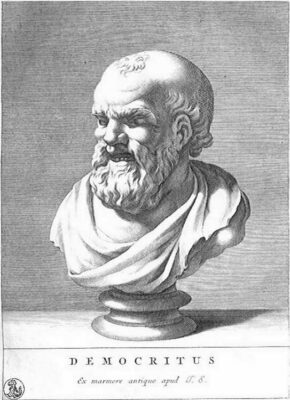
The physicist Pierre Gassendi (1592–1655) succeeded in making this hypothesis even acceptable for the (in those days) powerful Catholic church. In due time the idea that the world was not created by an unimaginable powerful and intelligent mind, but originated from haphazard collisions of equal elements became more and more accepted. There always was the possibility of course that those collisions had been guided by a higher force. So the atoms replaced God as an explanation of the creation of the world and with this the great chain of being suddenly became less obvious. Nevertheless the theory of atoms remained just a theory, a supposition. It was obvious that no one ever would be able to see an atom.
The theory of Kant was that the world we live in is not really created by God, nor originated from coincidental collations of atoms, but in fact did not really exist. The world is a phenomenon, an appearance, of an absolute reality that never appears to us, but is thinkable, he called it the noumenon. Theology and traditional metaphysics imagine themselves to know this world, but they both make the mistake to mix-up their representations with images from the world of appearances. That is the reason why God is supposed to be an old man with a beard and angels teenagers with the wings of a swan. It is impossible for us to know the absolute reality, but we can have some idea of it by studying the way things appear to us. From this we are able to deduce some of the mechanisms that necessarily have to take place in order to make the appearances possible. Our mind has therefore to be able to connect cause and effect and it is necessary for us to have a sense for space and time, etc.
What Kant actually had been was doing was making a subjectivist interpretation of metaphysical realism. He finishes with the metaphysical hierarchy, theology is limited by him to a logical structure and the remaining part of Christianity is no more than fancy stories for the believers. Every individual is a center of the interpretation by which the reality itself appears to him as that what we all are used to see as the real world. In this way science remains possible, because in our interpretations we all follow the same logical laws.
Just like in quantum mechanics, Kant left his descendants with a huge emptiness: absolute reality. Schopenhauer interpreted it as the will to live, Hegel as the absolute spirit and Nietzsche as the will to power. Every interpretation however remains speculative and problematic. Perhaps we should give up any metaphysics whatsoever and accept physical realism, the theory that the world we experience is all that exists.
- Arthur O. Lovejoy (1936): The Great Chain of Being, Harvard U.P.
- Erik Hoogcarspel (2005): The Central Philosophy, Basic Verses, Olive Press, Amsterdam
- https://www.nrc.nl/nieuws/2021/03/04/hoe-kwantumfysica-ons-wereldbeeld-op-zijn-kop-zet-a4034181
- Immanuel Kant (1995): Träme eines Geistersehes und andere vorkritische Schriften, Könemann Verl., Köln, p. 364
- Marc Richir (1976): Au delà du Reversion Copernicien, Martinus Nijhoff, Den Haag
- Michel Dijkstra (2012) Oosterse filosofie, 113. Stgn Instituut voor Filosofie, Amsterdam
- Sanne Bloemink (2021): Waarom de grootste revolutie in de wetenschap onzichtbaar is. Kwantum-groupie, in De Groene Amsterdammer 2021 nr. 31, August 4th 2021, https://www.groene.nl/artikel/kwantum-groupie
- Thomas A. Kochumuttom: (1989): A buddhist doctrine of experience, Motilal Banarsidas, Delhi
- Ulrich Libbrecht (2013), Burger van de wereld, Damon
Notes
[1] All translations are my own unless otherwise indicated.
[2] Representation of the paradox of Achilles and the tortoise according to the description of Jorge Luis Borges
[3] Source: Nāgārjuna
[4] Source: Cambodia museum to exhibit the worlds oldest zero, (January 2021)
[5] Source: Mayan zero (36 BCE)
[6] Source: Bernardo Kastrup
[7] Source: Shankara with his diciples
[8] Source: Immanuel Kant’s Critique of pure Reason (Title page of 1781 edition)
[9] Source: All Giza Pyramids in one shot
[10] Source: Four Mandalas of the Vajravali Series
[11] Source: Demokritos (c. 460-c. 370 BCE)

